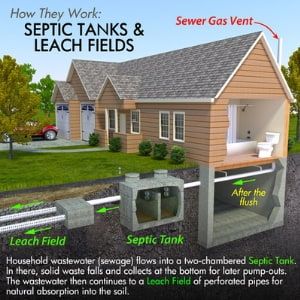Sewage is often thought of as toilet waste. However, sewage waste also includes any wastewater that comes from the bath, kitchen, washing machine, dishwater, even pool water. Sewer systems are used to carry our household waste to a sewage treatment plant.
Here it is treated so it can be reused. Many sewer systems are able to convert the sewage into clean water to be used again or returned to our waterways. City sewer systems are usually operated by local authorities to clean and remove household waste, perform minor repairs on sewer systems, damaged pipes, frames, and covers.
A sewer system utilizes underground pipes and aboveground equipment to carry household wastewater to treatment facilities. Septic tanks offer an on-site waste treatment system where public sewers are not an option, such as in rural areas. Pump stations and lift stations raise wastewater from a lower to a higher elevation.
Our City Sewer Systems
 Sewage system lines flow into larger pipes until they reach the wastewater treatment plant.
Sewage system lines flow into larger pipes until they reach the wastewater treatment plant.
Powered by gravity, these sewage treatment facilities are typically located in low-lying areas where sewer lines follow a downhill path until they reach the treatment facility.
After the waste is filtered, it moves into a sand container, where sand, ashes, and gravel settle at the bottom of the container. The gravity pull allows sewage to run through the pipes of each structure and sends the waste material to a sewer line that flows into larger vessels to the sewage treatment plant.
Septic Tanks in Rural Areas
 Usually found in densely populated, rural areas, septic systems are autonomous, underground sewage and wastewater treatment systems. They handle and dispose of wastewater onsite and are more economical than sewer systems because these rural areas are larger and homes are spread out far apart from each other.
Usually found in densely populated, rural areas, septic systems are autonomous, underground sewage and wastewater treatment systems. They handle and dispose of wastewater onsite and are more economical than sewer systems because these rural areas are larger and homes are spread out far apart from each other.
A septic treatment system is a waste treatment and disposal method located on site, deep in the ground. It is a box made of reinforced concrete or fiberglass. A septic tank requires pumping to extract the sludge in the tank that allows anaerobic bacterial action.
Maintenance of your septic tank is quick and simple and you can even do it yourself. Septic tanks carry sewage to a septic tank where good bacteria breaks down and filters waste, and it is sent to a sewage field. These reinforced square containers are found under the property grounds.
Waste Disposal Options
 You have options when it comes to treating wastewater in a sewage treatment plant, don't ever think you'll be constricted when it comes to dealing with your home.
You have options when it comes to treating wastewater in a sewage treatment plant, don't ever think you'll be constricted when it comes to dealing with your home.
Always check with your local public works department to inquire if any regulations against conventional sewage systems are in place.
Four of the most common waste removal systems include:
- Non-electrical sewage treatment plant
A sustainable home sewage treatment system does not consume energy and is a good option for septic tank upgrades and new construction.
Environmentally friendly sewage systems are ecological systems that are sustainably designed. They are economical, energy-efficient, and good for the planet. New technologies treat sewage as an energy and nutrient source. These sewer systems use eco-friendly methods to purify water and for recycling.
Their exact design is dependent on location, climate, and population, but all wastewater is to be moved through a controlled environment where plant and animal organisms modify the waste in the water.
"ECO" systems are a superior waste treatment options. They are good for the environment since they do not use electricity. Non-electrical sewage treatment facilities are favored among conservationists.
- Cesspool
Household sewage is carried to a waste tank by a cesspool waste removal system. This is where waste is broken down by chemicals into effluent to be dumped in approved landfills. Any untreated waste is used by dry wells.
Scum and sludge that build up in the tank are then filtered and removed. Septage dumping regulations are strict making cesspool sites rare.
- Gravity Drainage
Wastewater that exits a dwelling when drainage pipes are at a downward angle is called gravity drainage. Gravity pulls the waste, and the sewer line stays in this downward flow until it reaches a sewage treatment plant or septic tank.
Gravity drainage resulting from a difference in elevation to remove unwanted water will support a steady flow of water without energy consumption. Gravity drainage sewers can redirect waste into a container below ground where pumping is needed to drive sewage to a different location.
When the wastewater reaches the tank, it is filtered and returned. Gravity drainage systems can keep drain entrapment away. It is an ideal option for preventing central drain entrapment in residential and commercial pools.
- Pumping Station
Effluent that is used for drawing air into an aeration system and for moving wastewater into higher elevations is carried into a pumping station. Here, sewage collection systems are used to manage the raw sewage of subterrene gravity pipelines.
A complete sewer or septic tank examination by a certified specialist can cost you less than waiting for a problem to happen. Our plumbing experts at Pat Plumbing, Heating, Air and Electric can help with your sewer and drain cleaning services and needs. Technicians are standing by to help and to answer any questions you have.

